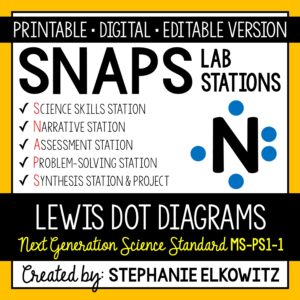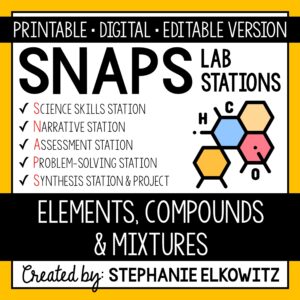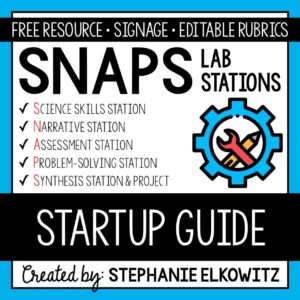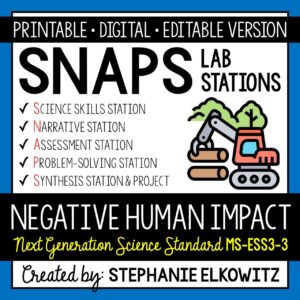HIV and AIDS Lab
$7.00
An engaging lab activity designed to enhance students’ understanding of the history, transmission, stages, and treatment of HIV and AIDS.
Description
SNAPs Lab Stations Activities require students to use science, math, literacy, problem-solving and engineering skills. They are designed to enhance students’ understanding of scientific concepts and help students apply scientific ideas to the real world. Each station activity promotes skills so to develop students into proficient and competent scientific thinkers.
SNAPs lab activities have five components:
• Science Skills Station to develop science skill proficiency
• Narrative Station to build science literacy
• Assessment Station to evaluate learning and understanding
• Problem-Solving Station to foster engineering design
• Synthesis Station and Project to inspire higher-order learning
DIGITAL LABORATORY – DISTANCE LEARNING & DIGITAL CLASSROOMS
• This lab is offered in a digital format to support digital classrooms & distance learning.
• The digital lab activity is designed to work with Google Slides and Microsoft PowerPoint
• The digital lab activity CANNOT be edited. However:
– Students can manipulate text boxes
– Students can create tables, graphs and diagrams
– Students can insert images and drawings
GOOGLE FORM ASSESSMENT STATION
• The assessment station is offered as a self-grading Google Form.
• Questions are all short answer and are 100% editable.
• Suggestions for use are included in the download.
DISTANCE LEARNING COMPATIBILITY
SNAPs lab activities are rated for their ease with distance – independent learning. Refer to the preview for more information about how well this laboratory works in a fully digital classroom and with distance learning.
EDITABLE DOCUMENTS
This download includes an editable word document (docx file) of all lab components:
• Pre-Lab and Post-Lab Activities
• The Lab Overview
• Lab Station Activities and Questions
• Directed Synthesis Project (when applicable)
Important Notes:
• Diagrams, illustrations, tables and graphs essential to lab activities are included
• Illustrative clipart is NOT included
• Editable documents and rubrics are included with the FREE SNAPs Setup Guide
Editable files allow you to:
• Edit the scope of the activities so to suit your students’ needs
• Edit the materials required based on resource availability
• Create single-period “mini-labs” using activities at the individual skills stations
The activities at each station in this lab are detailed below.
HIV/AIDS Lab Stations Activity Learning Objectives
1. Identify the methods by which HIV can be transmitted.
2. Describe the stages of the HIV reproductive (life) cycle.
3. Describe the three stages of HIV infection: acute infection, clinical latency and AIDS.
4. Conduct short research to understand the history of HIV and AIDS research.
5. Analyze data on the global HIV prevalence and distribution of deaths from HIV/AIDS.
6. Evaluate the treatment for HIV and AIDS.
Science Skills Station
Students will study HIV infection at this station. They will use animations to study the HIV life cycle and graphs to study the stages of HIV infection. Students will also analyze data about the prevalence of HIV infection and the global distribution of deaths from HIV/AIDS.
Narrative Station
Students will read and watch videos about HIV transmission, infection and treatment, including a video about developing a cure for HIV. An optional video (short documentary) about how living with HIV has changed since 1981 is included.
Assessment Station
Students will answer questions about key terms and ideas relating to HIV/AIDS. Students must employ lower, mid and higher order thinking skills to answer these questions.
Problem-Solving Station
Students will use an interactive timeline to identify milestones in HIV research and treatment. They will read about antiretroviral therapy (ART) and use animations to study reverse transcriptase and protease inhibitors. Students will learn about treatment to prevent perinatal transmission of HIV as well. An optional video about how treatment has changed over the year is included. Students have the opportunity to complete an enrichment activity to learn about the utilization of HIV in gene therapy and its (successful) use in curing SCID.
Synthesis Station
Students will compose a CER (claim-evidence-reasoning) report to summarize the lab. Students are provided the claim statement and must support the claim with observations, data and other information gathered in the lab. Students will explain how the evidence supports the claim using scientific reasoning.
Synthesis Project
Students will have a choice of 11 projects. Refer to the SNAPs Lab Stations Best Practices and Setup Guide for directions and suggestions on how to conduct the project.
This download includes:
• A pre-lab assignment and post-lab reflection
• Directions and questions for each lab station
• Student recording sheets
• Teacher Key
Additional Materials Required:
3 Computers or tablets
Scissors
Glue or tape
DISCLAIMER
Two optional activities in this lab include videos that reference mature topics including sexuality and stigma toward groups affected by HIV/AIDS. Educators should review the optional videos and use their professional judgment as to whether or not to include the activities.
LINKS TO VIDEOS
This laboratory requires internet to access videos. Videos are hosted on SafeShare.TV so to safely watch and share educational YouTube videos without ads, comments and other distractions. Shortened and full link(s) to SafeShare.TV included. Full link to original YouTube video(s) included.
NEXT GENERATION SCIENCE STANDARDS
This laboratory does not address a specific Next Generation Science Standard, but it complements NGSS concepts. It combines the three dimensions of science learning – science and engineering practices, disciplinary core ideas and crosscutting concepts – in order to meet the standard. This laboratory also makes interdisciplinary connections to STEM, Math CCSS and ELA CCSS to build the appropriate skills.
TERMS OF USE
• All rights reserved by Stephanie Elkowitz.
• This product is to be used by the original purchaser only.
• Intended for classroom and personal use only.
• Copying for more than one teacher, classroom, department, school, or school system is prohibited.
• This product may not be distributed or displayed digitally for public view.
• Failure to comply is a copyright infringement and a violation of the Digital Millennium Copyright Act (DMCA).








